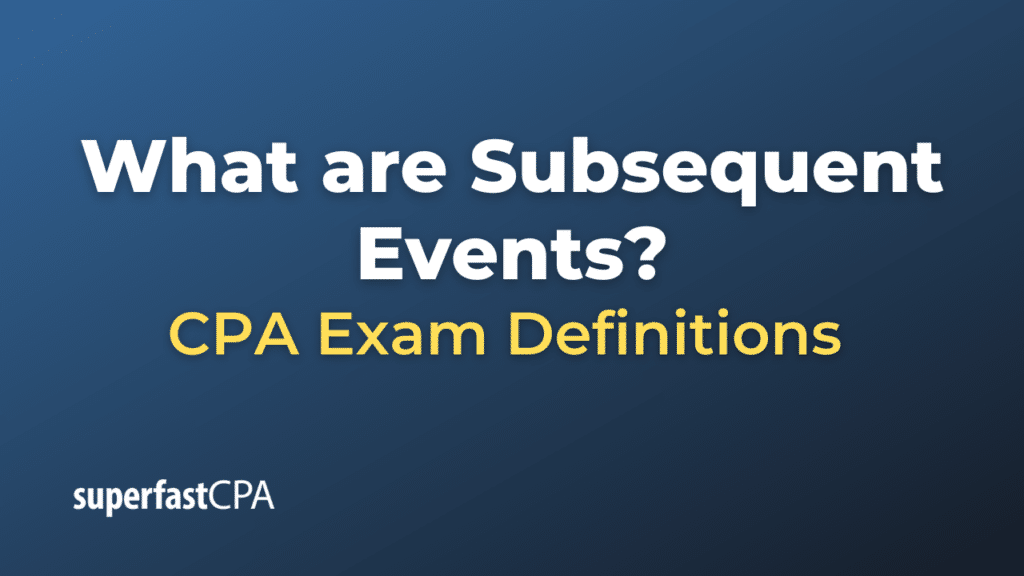Subsequent Events
Subsequent events, also known as post-balance sheet events or events after the reporting period, refer to significant events or transactions that occur after the balance sheet date but before the financial statements are issued or available to be issued. Accounting standards require companies to evaluate these events and determine if they need to be disclosed or recognized in the financial statements.
Subsequent events are classified into two categories:
- Recognized Subsequent Events (Type I)
- These are events that provide evidence about conditions that existed at the balance sheet date.
- They require adjustment to the financial statements. In other words, the amounts in the financial statements would be updated to reflect these events.
- Example: If a company’s inventory was valued at a certain amount on the balance sheet date, but a subsequent event reveals that the valuation was incorrect due to information available but not considered at that time, the financial statements should be adjusted.
- Non-Recognized Subsequent Events (Type II)
- These are events that provide evidence about conditions that did not exist at the balance sheet date and arose after that date.
- They do not require adjustment to the financial statements. However, if the event is material, it should be disclosed in the notes to the financial statements to keep users informed.
- Example: A significant lawsuit filed against the company or a major natural disaster impacting the company’s operations after the balance sheet date would be disclosed in the notes but wouldn’t lead to adjustments in the figures of the financial statements.
Here are a few examples of subsequent events:
- Settlement of a lawsuit for an amount different from what was accrued in the financial statements.
- Sale of a significant asset after the balance sheet date.
- Issuance of debt or equity securities.
- Declaration of dividends.
- Destruction of a major facility due to a natural disaster.
- Bankruptcy of a major customer that might affect the collectability of the account receivable from that customer.
It’s essential for companies to evaluate and disclose significant subsequent events because these events can provide crucial information to financial statement users regarding the company’s financial position and the potential risks it may face in the future. Proper disclosure ensures transparency and aids in better decision-making by investors, creditors, and other stakeholders.
Example of Subsequent Events
Let’s delve into a fictional example involving a subsequent event:
Scenario: “ElectroMotive Inc.”
Background: ElectroMotive Inc. is a company specializing in the production of electric cars. The company’s balance sheet date is December 31, 2023, and they are set to issue their financial statements on March 15, 2024.
Event: On February 10, 2024, a fire broke out at one of ElectroMotive’s major production facilities, causing significant damage and halting production indefinitely.
Analysis:
Given the date of this unfortunate incident, it’s clear that the fire is a subsequent event because it occurred after the balance sheet date (December 31, 2023) but before the financial statements were issued (March 15, 2024).
Now, let’s classify the event:
- Recognized Subsequent Event (Type I):
- Does the fire provide evidence about conditions that existed at the balance sheet date?
- In this case, no. The fire’s occurrence and the associated damage didn’t exist as of December 31, 2023.
- Non-Recognized Subsequent Event (Type II):
- Does the fire provide evidence about conditions arising after the balance sheet date?
- Yes, it does. The destruction of the facility is a significant event that arose after the balance sheet date.
Financial Statement Treatment:
Given that this is a non-recognized subsequent event, ElectroMotive Inc. would not adjust its financial statement figures as of December 31, 2023, to account for the fire’s damages. However, since the incident is material and has significant implications for the company’s future operations and financial position, ElectroMotive should disclose the event in the notes to the financial statements.
The disclosure might look something like this:
“Subsequent to the balance sheet date, on February 10, 2024, a fire occurred at one of our primary production facilities, causing significant damages. The facility has been temporarily shut down for repairs, and the company is in the process of assessing the financial impact and insurance claims related to the damages. The financial statements as of December 31, 2023, do not reflect any adjustments related to this event.”
This example helps illustrate the importance of subsequent events. Even though the financial statement figures aren’t adjusted, the disclosure provides crucial information to stakeholders about significant events affecting the company post-balance sheet date.













